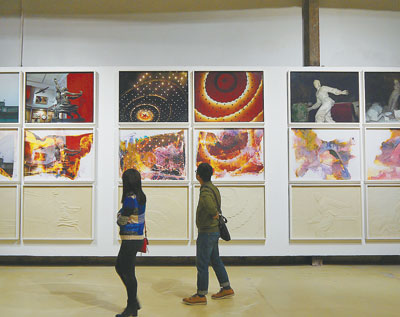|

Cao Zhen
caozhen0806@126.com
“NEW Works,” an exhibition introducing new Chinese artworks, as well as new perspectives on past works, is being held at OCT Contemporary Art Terminal (OCAT) in Nanshan District.
The exhibition is divided into three sections: “From the Issue of Art to the Issue of Position: Echoes of Socialist Realism,” “Keep the Modern Going: Immersion, Awaiting and Idealism” and “Multi-Future.”
The exhibition, showcasing oil paintings, installations, video, dramas and fine art research in China from 1949 to 2013, attempts to reassess how realism influences and molds art.
“We hope to place the discussion of art in a framework that is parallel to the intellectual history in China and to consider the movement of art in close relationship to the process of modernization in China,” said Lu Yinghua, one of the curators of the exhibition. Lu is the artistic director of OCAT.
In some new works created last year, artists apply abstract representation to realist paintings. In Wang Shang’s unfinished oil painting “Untitled,” he uses gems as a metaphor to depict the beauty and insignificance of life. The work has been going on for nearly a year, with at least another year’s time left until completion.
Wang took jewelry appraisal courses and apprenticed in a jewelry shop while studying in Britain for his master’s degree in art. His fascination with gems explains his repeated use of jewelry in his artworks. He called his metaphor of gemstones as “Neo-naturalism.” “The process of tiny minerals deep underground being pressured for eras to become gemstones is similar to birth giving and production. Their mysterious, undeniable beauty indicates the uncertainty and brilliance of life. Whereas their identifiable chemical formula and ultimate fate to degradation casts doubt on real-life values,” he said.
In artist Duan Zhengqu’s oil painting “Holiday in the Countryside,” he depicts farmers, local customs and daily life scenes in the northern Shanxi mountainous area. The painting employs the technique of layered slight paint, which makes clear lines diffused and shaded, and matte black images vivid and smooth.
An associate professor in the Fine Arts Department of Capital Normal University in Beijing, Duan has been studying the techniques in classical oil painting and modern art movements for years. His latest efforts involve collecting faces online for his new paintings of group portraits.
The exhibition also presents some rethinking and reevaluation of old works. It studies Chinese contemporary art as early as the year 1949, instead of starting from the 1980s. “To revisit the past is to rediscover the work and ideas that were yet to be fully explored and recognized. It is to expand the historical dimensions within which we study Chinese art and to position our current work in a richer and more open context,” said curator Lu.
The exhibited Chinese artworks created from 1949 to the end of the Cultural Revolution in 1976 reflect the socialist realism style, which often glorifies the roles of the working class. While realistic paintings in the late 1980s and 1990s depict the real, sometimes negative, aspects of life. Scenes that took place in people’s homes, on the streets, in parks and on buses are seen in that era’s artworks.
Song Yonghong is one of the artists who painted ordinary people’s lives in the 1990s. Sex is overtly featured in his works, such as “Night Flag” (1997). With sexual acts secretly taking place in public spaces, such as on the lawn, by the riverside, in woods or inside offices, the joy, anxiety, sadness and even humiliation displayed in his paintings vividly reflect Chinese people’s attitude toward sex during that time.
Huang Liaoyuan, an art critic, has pointed out the similarities between Song and Polish modern artist Balthus in their erotic imagery, stating that Balthus’ is voyeurism while Song’s is crude eroticism.
At the exhibition, visitors can also watch China’s earliest experimental play “Absolute Signal” through a TV screen. Directed by Lin Zhaohua in 1982, the play centers on an unemployed young man planning to rob on a train. It switches frequently between reality, memory and dream, making the play detached from the realistic narrative. The drama applies many surrealist sound effects and lighting arrangements, creating a modernistic depiction of the characters’ subjective world.
Although initially criticized as lacking in deep thoughts, it was a landmark. Achieving genuine communication with the audience, the drama was a pioneering example of China’s avant-garde theater. Critic Tong Dongming once wrote: “Thanks to ‘Absolute Signal,’ China finally joined in the global wave of small-theater drama movement.” After “Absolute Signal,” Lin directed two other experimental dramas, “Bus Stop” (1983) and “Wildman” (1985).
Dates: Until April 12
Hours: 10 a.m.-5:30 p.m. Closed Mondays
Venue: Hall A and B, OCAT, south area of OCT-LOFT, Enping Road, Overseas Chinese Town, Nanshan District (南山区华侨城恩平路创意文化园南区OCT当代艺术中心A、B展厅)
Metro: Luobao Line, Qiaocheng East Station (侨城东站), Exit A
|

